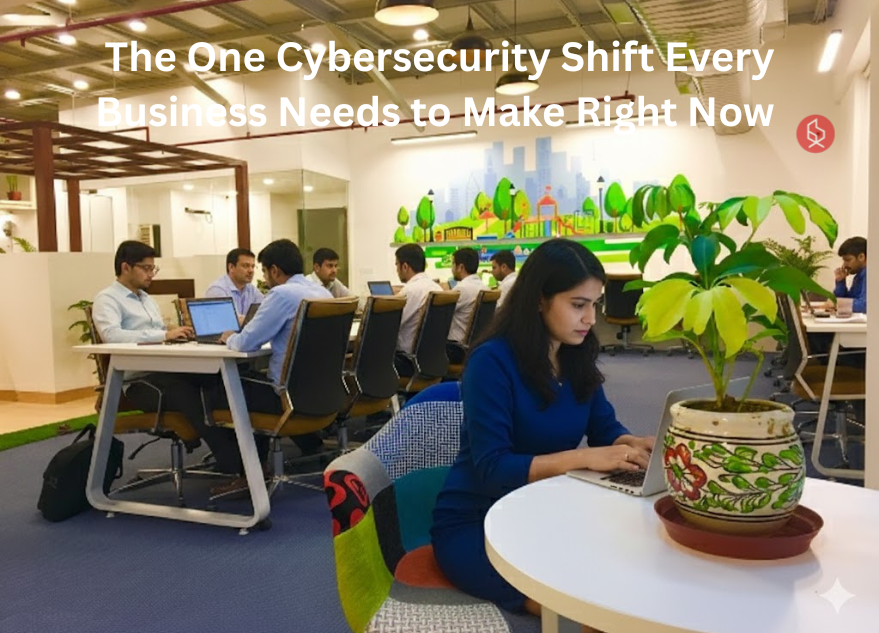Cybersecurity threats are no longer a question of “if” but “when,” especially for growing businesses. The one strategic shift that addresses this modern reality is moving from a “trust-but-verify” model to a “Zero Trust” model.
💡 Are you looking for Coworking space in Gurgaon, Noida or Delhi? We are just a call away. Call Now: 08999 828282
10 Cybersecurity Best Practices for Long-Term Protection
- What “Zero Trust” Actually Means
- Why the Old “Castle-and-Moat” Model Is Broken
- Start with Multi-Factor Authentication (MFA)
- Enforce the “Principle of Least Privilege”
- Micro-segmentation: Building Walls Inside Your Network
- Secure Every Endpoint, Everywhere
- Continuously Monitor and Respond
- Focus on the Human Element: Your “Human Firewall”
- Secure Your Data, Not Just Your Network
- Make Security an Ongoing Business Process
1. What “Zero Trust” Actually Means
The single most important shift in cybersecurity for businesses is a change in mindset. The old way was “trust but verify,” where we built a strong wall (a firewall) and trusted anyone who was inside. The new, essential model is Zero Trust, which operates on the principle of “never trust, always verify.” This means every single user, device, and application whether inside or outside your network must be verified before being granted access to data. It’s not a single product you buy; it’s a strategic approach and a fundamental cybersecurity best practice for the modern, remote-work world.

2. Why the Old “Castle-and-Moat” Model Is Broken
For decades, businesses treated cybersecurity like a medieval castle. You built a strong wall and a deep moat (your firewall) to keep bad actors out. The assumption was that everyone inside the walls was a trusted employee. Today, this model is dangerously obsolete. With cloud applications, remote workers, and personal devices (BYOD), the “network perimeter” is gone. A hacker who steals one employee’s password can instantly be “inside” and move freely, accessing everything. Zero Trust assumes the attacker is already inside and builds defenses accordingly.
3. Start with Multi-Factor Authentication (MFA)
This is the most practical, high-impact first step toward Zero Trust. MFA is a non-negotiable cybersecurity best practice. It requires users to present two or more pieces of evidence (factors) to prove their identity. This is typically something they know (a password), something they have (a code from a phone app), and/or something they are (a fingerprint). Even if a hacker steals an employee’s password, they cannot log in without the second factor. Implementing MFA across all your critical apps especially email, banking, and admin panels is the fastest way to neutralize the risk of stolen credentials.
Also Read: The Cyber Risk SMBs Can’t Afford To Ignore
4. Enforce the “Principle of Least Privilege”
A core pillar of Zero Trust is the “principle of least privilege.” This simply means that every user, application, and device should only have the absolute minimum level of access necessary to perform its specific job. Your marketing intern should not have access to your financial records, and your sales software shouldn’t be able to access your developer’s code. This is one of the most effective cybersecurity best practices because it dramatically limits the “blast radius” of an attack. If a single account is compromised, the attacker is trapped and cannot access your most sensitive data.
5. Micro-segmentation: Building Walls Inside Your Network
If “least privilege” limits user access, micro-segmentation limits network access. Think of it as building small, secure rooms inside your “castle.” Instead of a single open-plan network where everything can communicate with everything else, micro-segmentation divides the network into small, isolated zones. Your server for customer data, for example, should be in its own segment and only allowed to communicate with the specific applications that require it and nothing else. If an attacker breaches one server, they are confined to that single “room” and cannot move laterally across your network to find more valuable targets.
6. Secure Every Endpoint, Everywhere
In a Zero Trust world, the “endpoint” the laptop, phone, or tablet is the new perimeter. Your cybersecurity for businesses strategy must assume these devices will be used on untrusted networks, like public Wi-Fi. This means every endpoint needs its own defenses. This includes using modern endpoint detection and response (EDR) tools, enforcing the use of screen locks and strong passwords, ensuring all software is patched and up-to-date, and having the ability to wipe a device if it is lost or stolen remotely. A weak endpoint is an open door for an attacker.
7. Continuously Monitor and Respond
Zero Trust is not a “set it and forget it” solution; it’s an active, ongoing process. You must assume that attackers are already attempting to gain access. This requires you to monitor all activity on your network continuously. By logging and analyzing who is accessing what, from where, and when, you can build a baseline of “normal” behavior. When an anomaly occurs such as a user logging in from two different countries simultaneously your system can automatically flag it, demand re-authentication, or even lock the account. This proactive monitoring is the key to catching a breach before it becomes a catastrophe.
8. Focus on the Human Element: Your “Human Firewall”
Your technology is only one part of your defense. The most sophisticated cybersecurity best practices can be compromised by a single employee clicking a phishing link. The shift to Zero Trust must encompass a cultural shift. You must invest in continuous, engaging security awareness training. Teach your team how to spot sophisticated phishing emails, the dangers of social engineering, and the importance of good “cyber hygiene.” When your employees are trained to be skeptical and to report suspicious activity, they transform from your biggest vulnerability into your strongest line of defense.
💡 Are you looking for Coworking space in Gurgaon, Noida or Delhi? We are just a call away. Call Now: 08999 828282
9. Secure Your Data, Not Just Your Network
In a Zero Trust model, you protect the data itself. This is a crucial pivot from just protecting the network. The best way to do this is through robust encryption. Your sensitive data should be encrypted “at rest” (when it’s stored on a server) and “in transit” (when it’s being transmitted over the internet). This way, even if an attacker manages to steal a file, it’s just a block of useless, unreadable code to them. By classifying your data (public, internal, confidential), you can apply the right level of security and access control to your most critical digital assets.
10. Make Security an Ongoing Business Process
Ultimately, the Zero Trust shift is a move from treating cybersecurity as a one-time IT project to integrating it as a core, ongoing business process. It’s not just a technical problem; it’s a business strategy for resilience. This means security must have a voice in business decisions, from vetting new software vendors to planning new products. A strong security posture is a competitive advantage. It builds trust with your customers, protects your reputation, and ensures your business can survive and thrive in an increasingly hostile digital environment.
The shift to a Zero Trust model is the most critical cybersecurity decision a business can make today. It moves your company from a fragile, reactive posture to a resilient, proactive one. By embracing cybersecurity best practices like MFA, least privilege, and continuous monitoring, you build a foundation that protects your data, your customers, and your reputation for the long haul.
And as your teams collaborate across flexible workspaces, partnering with The Office Pass (TOP) gives you the added advantage of secure, well-managed neighbourhood coworking offices across Delhi-NCR. To explore workspace options that complement your Zero Trust approach, call 8999 828282.
FREQUENTLY ASKED QUESTIONS (FAQS):
Question: What is the “one shift” in cybersecurity all businesses need?
Answer: The “one shift” is moving to a Zero Trust security model. This is a change in mindset from “trust but verify” to “never trust, always verify.” It means no user or device is trusted by default, even if it’s already inside your network.
Question: Is Zero Trust too complicated for a small business?
Answer: No. Zero Trust is a scalable strategy, not a single expensive product. A small business can start implementing its core principles today by enforcing Multi-Factor Authentication (MFA) and the “principle of least privilege.” These two steps alone will dramatically improve your security.
Question: What is the most common cybersecurity threat for businesses?
Answer: The most common and effective threat is phishing, a form of social engineering. These are deceptive emails, texts, or messages designed to trick an employee into revealing a password or clicking a malicious link. This is why employee training is a critical cybersecurity best practice.
Question: What is Multi-Factor Authentication (MFA)?
Answer: MFA (also called 2FA) is a security method that requires a user to provide two or more forms of identification to log in. This is usually your password (something you know) plus a code from your phone (something you have). It’s the best defense against stolen passwords.
I use a VPN. Isn’t that enough? No. A traditional VPN operates on the old “castle-and-moat” model. Once a user is authenticated with the VPN, they are “inside” and often have broad access. If an attacker steals that user’s VPN login, they are free to move around your network.
Question: What is the “principle of least privilege”?
Answer: This is a core concept of Zero Trust. It means giving any user (or application) only the minimum permissions they need to do their specific job, and nothing more. This limits the damage an attacker can do if they compromise an account.
Question: How often should I train my employees on cybersecurity?
Answer: Cybersecurity training should be a continuous process, not a one-time event. Experts recommend formal training at least annually, with ongoing phishing simulations and security reminders sent quarterly or monthly to keep your team vigilant.
Question: What is a “phishing” attack?
Answer: A phishing attack uses fraudulent communication, like an email, that appears to be from a legitimate source (like your bank or a vendor). The goal is to lure you into revealing sensitive information, such as login credentials, credit card numbers, or other personal data.
Question: What’s the very first step to implement Zero Trust?
Answer: The best first step is to identify your most sensitive data and turn on Multi-Factor Authentication (MFA) for all users, especially administrators. This immediately protects your most valuable assets and accounts.
Question: Does using cloud services make me more or less secure?
Answer: It depends. Major cloud providers (like Google, Amazon, and Microsoft) have incredibly robust security, but they operate on a “shared responsibility model.” They secure the infrastructure, but you are responsible for securing your data and applications by configuring your settings correctly.



